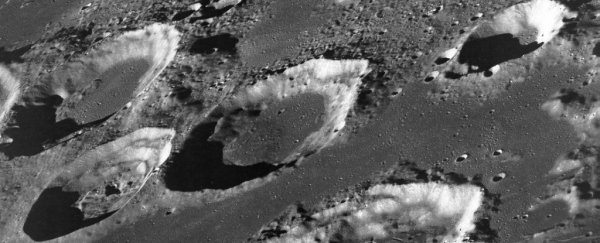You only have to take a look at the Moon to see that it's had something of a rough time during its roughly 4.5-billion-year history, but a new study suggests that it's survived more early asteroid hits than its surface actually shows today.
The new research proposes that some of the oldest impacts on the Moon left near-invisible imprints because they were striking a softer surface: The global ocean of magma that covered the Moon in its youth before it cooled and solidified.
These relatively soft landings, leaving next to no permanent trace of ever having happened, could explain why the Moon as it currently looks doesn't match up with what scientists think happened to it in the first billion years or so.
"These large impact craters, often referred to as impact basins – formed during the lunar magma ocean solidification more than four billion years ago – should have produced different looking craters, in comparison to those formed later in geologic history," says planetary scientist Katarina Miljkovic from Curtin University in Australia.
The idea of a global magma ocean on the Moon is by no means new, but the research digs deeper into the potential timeline of magma and asteroid hits – and tries to line it up with what we think we know about what was happening in the Solar System at the time.
We have multiple clues as to what's happened to the Moon since it was formed, from Solar System modeling to evidence of impact shocks in rocks that have actually been recovered from the surface by Apollo astronauts.
Some studies suggest the boiling lakes of magma could have stayed around for as many as 200 million years, and this latest research shows how that would fit in with the dates suggested for an early bombardment of large asteroids.
"The timeframe for the solidification of the lunar magma ocean varies significantly between different studies, but it could have been prolonged enough to experience some of the large impact bombardment history typical for the earliest periods of the Solar System evolution," says Miljkovic.
"As the Moon ages and the surface cools, it becomes harder, and the bombardment imprints are a lot more noticeable by remote sensing."
This is all hugely important in establishing how the Solar System came to be the way it is – and from that, learning more about how planets actually form and how long they stay in particular states for.
Even knowing that there's an unknown involved, like how many asteroid hits could have been missed by previous assessments of the lunar cratering record, helps to improve models of what was going on billions of years ago.
And because we're such near neighbors to the Moon, anything that happened to it would have had some effect on Earth too – giving us a better understanding of how our planet and the life on it came into being.
"Translating this finding will help future research understand the impact that the early Earth could have experienced and how it would have affected our planet's evolution," says Miljkovic.
The research has been published in Nature Communications.
